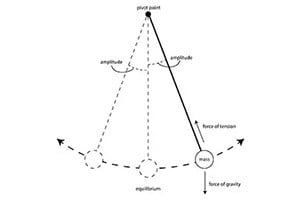This is the teacher guide for this lesson. A student-focused guide to assist learners as they perform the activity is available.

Swinging Science
Experimenting with forces and variables of swinging objects.
What variables affect the period of a swinging object?
This resource was originally published in PhysicsQuest 2020: Force & Motion.
What variables affect the period of a swinging object?
- 2 lengths strings
- 4 hex nuts
- A ruler or measuring tape (optional)
- A timer (optional)
- Sheets of graph paper (optional)
In this experiment, students will experiment with different variables so see which ones affect the motion of a pendulum. They will be able to alter the variables as they would like to determine that mass is not a variable that affects the motion of a pendulum.
- Total time45 - 60 Minutes
- Education levelGrades 5 - 9
- Content AreaForce & Motion
- Educational topicGravity, period
The simplest pendulum has a string with a mass at the end. To start a pendulum swinging, the first thing to do is pull the mass back a little bit, keeping the string straight. When it is pulled back and held, gravity is pulling directly toward the ground and the string is pulling up toward the pivot point. No matter what happens to the mass of the pendulum throughout the swing, gravity will always be pulling straight toward the ground and the string will keep pulling toward the pivot point.
When you let the mass go, gravity pulls it down and the pendulum starts to swing. As it swings, it speeds up as gravity makes it accelerate. Because the string is holding it up, it swings in an arc. When it is at the bottom of its swing the mass is moving as fast as it can and gravity is pulling straight down and the string is pulling straight up. As it swings through the lowest point it starts to swing up the other way, and gravity is now working to slow it down. When the pendulum gets to the top of its swing, it has been slowed down to a stop and the whole process repeats in the other direction.
So what affects how fast a pendulum swings? Gravity is one variable. A pendulum on the moon or Mars would swing at a different speed than one on Earth because the force of gravity would be different. What about a pendulum in space? What would happen if you changed the mass at the end of the string? In Activity One, we learned that different masses always fall at the same rate. Because of this, changing the pendulum’s mass will not change how fast it swings.
What happens if you start the pendulum’s swing from a greater height, giving it a greater amplitude? It will still take the same time to get through one swing, it will just be going faster at the bottom of the swing. The pendulum has more time to speed up as it is swinging, so it is going faster, but because it is going faster, it covers a larger distance in the same amount of time as a pendulum with a shorter amplitude.
The variable to change is the length of the string. This is the only variable (that we can easily change) that affects the period of a pendulum. The longer the string, the more time it takes for the pendulum to go through one swing. So if you want to design a swing for the playground to go back and forth faster or slower, then you need to change the length of the chains from the pivot point to the swing’s seat. If you’ve ever used a metronome while practicing music, you will remember that the metrinome’s speed is set by sliding the mass.
These are the key terms that students should know by the END of the two lessons. They do not need to be front loaded. In fact, studies show that presenting key terms to students before the lesson may not be as effective as having students observe and witness the phenomenon the key terms illustrate beforehand and learn the formalized words afterwards. For this reason, we recommend allowing students to grapple with the experiments without knowing these words and then exposing them to the formalized definitions afterwards in the context of what they learned.
However, if these words are helpful for students on an IEP, ELL students, or anyone else that may need more support, please use at your discretion.
- Mass: A measure of the amount of stuff (or matter) an object has. Not to be confused with weight or volume. Mass only says how much actual stuff there is, not how big an object is or how hard something is pulling on it.
- Force: The push or pull an object feels because of interactions with other objects. If the interaction stops, then there is no force. It is formally defined as mass times acceleration. For example, gravity is a force that represents the pull the Earth has on all objects.
- Period: The amount of time it takes for a pendulum to make one whole swing; that means swinging from left to right and left again.
- Pivot Point: The fixed point a pendulum swings from.When you're on a swing, the swing is attached to a bar or a tree branch. As you swing back and forth, the bar above you does not move. The bar is the fixed pivot point.
- Amplitude: How high a pendulum swings from the middle point. The middle point is the place where the swing is when it is at rest.
- Independent Variable: This is a variable that can be changed by the person doing the experiment. For an experiment with a pendulum, some examples include length of the string, , mass (how much stuff is at the end of the string), and amplitude (how high do the pendulum starts from).
- Dependent Variable: This is a variable that cannot be changed by the person doing the experiment but changes based on the independent variable. In this experiment, one of the dependent variables is the pendulum’s period.
Students will understand the motion of a pendulum and be able to develop of visual model.
It is important to understand that student goals may be different and unique from the lesson goals. We recommend leaving room for students to set their own goals for each activity.
Use the Snowball Protocol to Ask & Discuss: Think about and draw two kids who are swinging at recess. What will affect how fast or how high they swing?
- Students begin in pairs, responding to a discussion question only with a single partner.
- After each person has had a chance to share their ideas, the pair joins another pair, creating a group of four.
- Pairs share their ideas with the pair they just joined.
- Groups of four join together to form groups of eight, and so on, until the whole class is joined up in one large discussion.
In the student’s guide we have asked the students to design their own experiment to test what variables affect a pendulum’s swing. The idea is to encourage them to be creative, to understand how to design experiments, and to think like scientists and engineers. They are given a set of materials that they can use to do their experiments. This is to prompt them, but they should be allowed to use other materials in their design. As the teacher, you can ask prompting questions to get them to think about the different aspects of the experiments. We have included instructions for how to set up the experiment with the just materials included in the kit.
The goal of the experiment is that students understand that mass is not a factor that affects the pendulum’s period. Using the nuts which are of equal mass, they can test if by adding more mass changes the pendulum’s swing. Students should decide which variables they should control for, such as the number of nuts, the length of the string, the angle at which the nut is released , if there is a strong air current that could affect the swing, and consistency of the repeated experiments.
Use the Discussion Diamond Protocol to have students answer the conclusion prompt: Use your graph to explain what variables affect the period of a swinging object.
- The teacher poses a question that students can answer with data.
- All students get three minutes to think and write their thoughts in their respective corners.
- The students take turns explaining their ideas to each other (all students must share).
- The students discuss what their consensus view might be and write their consensus view in the middle.
Suggested STEP UP Everyday Actions to incorporate into activity:
- When pairing students, try to have male/female partners and invite female students to share their ideas first.
- As you put students into groups, consider having female or minority students take the leadership role.
- Take note of female participation. If they seem to be taking direction and following along, elevate their voice by asking them a question about their experiment.
- Consider using white boards so students have time to work through their ideas and brainstorms before saying them out loud.
- As students experiment, roam around the room to listen in on discussion and notice experiment techniques. If needed, stop the class and call over to a certain group that has hit on an important concept.
Consider using the RIP protocol (Research, Instruct, Plan) for lab group visits and conferring.
Consider culturally responsive tools and strategies and/or open ended reflection questions to help push student thinking, evidence tracking, and connections to their lives.
- Choice 1: Sign up for Physicists To-Go to have a scientist talk to your students.
- Choice 2: Create a video for younger students, how would you explain these concepts to them?
- Choice 3: Have students write their own definition for key terms using evidence from experiments to support their definitions.
- Choice 4: Conduct a discussion about how experimentation and evidence lead scientists to change their models.
- https://colab.research.google.com/drive/1_XMs_Aj59Fn9-_QldSwbjh_VOzDdA_RJ?usp=sharing
Credits
Coordination, Research, Text, and Editorial Review Claudia Frachiolla, Jamie Liu, Leah Poffenberger, James Roche, Laurie Tangren, Rose Villatoro, David Voss
Graphic Design and Production Meghan White
Illustrations Isabel Bishop
Updated in 2023 by Sierra Crandell, M.Ed. partially funded by Eucalyptus Foundation
Extension by Jenna Tempkin with Society of Physics Students (SPS)
